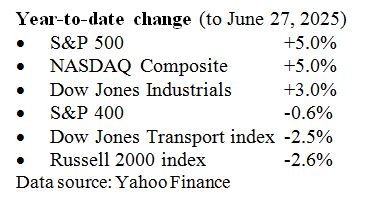by Louis Navellier
October 22, 2024
The most advanced AI models today need to be contained inside a single building, where tens (and soon hundreds) of thousands of AI processors, such as Nvidia’s H100s or Blackwell GPUs, can be connected so they can act as one computer. However, as Microsoft and its cloud computing competitors strive to build the world’s most powerful AI models, several factors, including limited energy grids, will create a cap on the size of a single data center, which are anticipated to consume multiple gigawatts of power, or the equivalent of enough energy to serve the electric needs of hundreds of thousands of homes.
Microsoft Azure Chief Technology Officer, Mark Russinovich, said data centers that make generative AI products like ChatGPT possible will soon reach their size limits, effectively necessitating a new method of connecting multiple data centers together for future generations of their AI technology.
No wonder Microsoft got Constellation Energy to reactivate a nuclear reactor on Three Mile Island! So, as the AI arms race continues, insane power demands are now unfolding, so it appears the U.S. electricity grid will have to double, and big natural gas electric plants with turbines the size of trains will have to be permitted, if hydroelectric and nuclear power cannot meet the needs of the cloud computing industry.
Speaking of energy, California is apparently trying to “Trump-Proof” its climate policies, according to The New York Times. In a statement, California Governor Gavin Newsom said, “California has long led the nation in pioneering climate policies and innovation,” adding that, “Those efforts will continue for years to come. That includes partnerships with private companies, such as automakers, and agreements with other countries —from China to Norway to Canada — to combat the climate crisis together.”
Interestingly, Newsom is trying to get communities to abandon natural gas hook-ups, so they go all electric in homes. Specifically, California Senate Bill 1221 will provide electric appliances to residents at no cost if their communities abandon natural gas. Obviously, California is trying to curtail natural gas use, despite losing multiple battles in federal courts. Frankly, I think these efforts to eliminate natural gas appliances are futile, since there is nothing better than sitting by a natural gas fire pit on the California coast as the fog rolls in, which is why the Lodge at Pebble Beach has many fire-pits at its outdoor restaurant!
The energy markets remain on edge due to the prospect of a likelihood of war escalation in the Middle East. Last Thursday, the Energy Information Administration (EIA) announced that our crude oil in the Strategic Petroleum Reserve fell by another 2.2 million barrels, to 420.5 million barrels in the latest week.
The EIA also reported that U.S. crude oil production rose by 100,000 barrels a day to a record 13.5 million barrels a day in the latest week. Both gasoline and distillate inventories declined in the latest week, which may be due to Hurricane Milton, since consumers tend to hoard fuel before a hurricane.
Energy Supplies Are Also Being Tested by Two Hot Wars
Last Wednesday, The Wall Street Journal published an article entitled, “Nuclear War Risks Rise Again, Stoked by Global Conflicts.” Apparently, a 4.6 magnitude earthquake struck Northern Iran several days ago, and this raised speculation that this “earthquake” was in reality a nuclear test being conducted. However, the epicenter was deep within the earth’s crust, so I’m betting it was a quake. Still, as a result, it’s likely that Israel will make plans to attack Iran’s nuclear sites before they develop a nuclear bomb.
Speaking of World War III, the U.S. is installing and operating a high-altitude missile defense system (the Terminal High Altitude Area Defense system, or THAAD) in Israel. THAAD requires six truck-mounted launchers, with eight interceptors on each launcher and powerful radar, which requires about 100 soldiers to operate. Obviously, the THAAD system is meant to intercept long-range ballistic missiles from Iran. It is now widely perceived that when Israel retaliates against Iran it will only be against military targets, so its crude oil infrastructure will be spared. As a result, Iran’s crude oil exports of up to a million barrels per day are expected to continue, meaning crude oil prices will remain low if war action remains limited.
The semiconductor industry has suffered its own kind of earthquake last Tuesday when ASML lowered its guidance for 2025 total net sales to between 30 billion and 35 billion euros ($33-$38 billion), compared to its previous guidance of up to 40 billion euros ($43.5 billion). ASML didn’t give any detailed explanation as to why its bookings fell so short of estimates, beyond a few delays in plant constructions.
As winter approaches, fighting in Ukraine is expected to slow. Russia is gaining ground on the Eastern front due to a relentless offensive that has cost up to 1,200 troop deaths per day. However, Russia has a lot more troops to lose than Ukraine, so Ukraine cannot defend some regions on the Eastern front. There are reports that Ukrainian recruiters are conducting raids as they are desperate for more troops after three years of fighting.
According to The Wall Street Journal, “Russian missile-and-drone attacks targeting Ukraine’s energy infrastructure are overwhelming the country’s air defenses, forcing rolling blackouts across the country that could worsen in winter” (“Ukraine Faces Bleak Winter as Russia Ramps Up Assaults,” October 14, 2024). Clearly, our new President-elect may have to force Ukraine to accept a ceasefire agreement.
U.S. Economic Indicators Are “Mixed” But Still Net Positive
The Commerce Department announced last week that September retail sales rose 0.4% (month over month), which was better than economists expected. Clothing sales surged 1.5% and were likely aided by back-to-school sales. Ten of 13 surveyed categories reported gains in September, so this was a very bullish report. In fact, excluding vehicle and gas station sales, retail sales rose by an impressive 0.7% in September. In the past 12 months, retail sales have risen 5.3%, which is faster than the inflation rate.
After this healthy retail sales report came out, the Atlanta Fed raised its third-quarter GDP estimate to a 3.4% annual pace, up from 3.2% previously reported. However, we are still in the midst of a recession in manufacturing. The latest evidence in that category is that the Fed reported industrial production declined 0.3% in September and manufacturing activity declined 0.4%. The Boeing strike and the recent hurricane destruction is also putting downward pressure on manufacturing activity. The fact that Boeing announced a layoff of 17,000 workers and is now raising capital, bodes poorly for any quick turnaround.
The housing industry also continues to struggle, since the Commerce Department announced on Friday that housing starts declined 0.5% in September to an annual pace of 1.35 million. Although single-family housing starts rose 2.7% in September, to an annual pace of 1.03 million, multi-family starts declined by 9.7%, to a four-month low. Building permits in September declined 2.9%, to an annual pace of 1.43 million, but single-family home permits rose slightly (by 0.3%) to an annual pace of 970,000. The latest increase in mortgage yields, after declining for several weeks, may also be impacting the housing sector.
On the surface, China’s economy seems to be doing better than the U.S., but I’m suspicious of their data. On Friday, China’s National Bureau of Statistics announced that its GDP grew at a 4.6% annual pace in the third quarter, which is the slowest official growth pace in the past six quarters, but China’s official GDP is usually viewed with skepticism. At least it is decelerating, and it is consistent with other data. China’s exports rose 2.4% in September, which represents the sixth straight month of rising exports.
The bad news is that China’s export growth decelerated from August’s 8.7% pace. Economists were expecting exports to grow at a 6% annual pace in September. The European Union tariffs on Chinese-made electric vehicles (EVs) may finally be impacting China’s exports. Concerns about China’s economic growth persist, regardless of all the economic incentives that the leaders in Beijing have implemented.
One more reason to remain optimistic is the fact that the M2 money supply (cash and savings accounts, excluding retirement accounts and CDs above $100,000) has surged in recent months. The stock market is closely correlated to M2, so as money supply surges, the stock market has historically risen.
Navellier & Associates owns Microsoft (MSFT), and Nvidia Corp (NVDA), in managed accounts. We do not own Constellation Energy (CEG) or ASML Holdings Inc. (ASML). Louis Navellier and his family own Microsoft (MSFT), and Nvidia Corp (NVDA), via a Navellier managed account, and Nvidia Corp (NVDA), in a personal account. He does not personally own Constellation Energy (CEG) or ASML Holdings Inc. (ASML).
The post 10-22-24: Future Electricity Demands Require a Massive Energy Infrastructure appeared first on Navellier.






